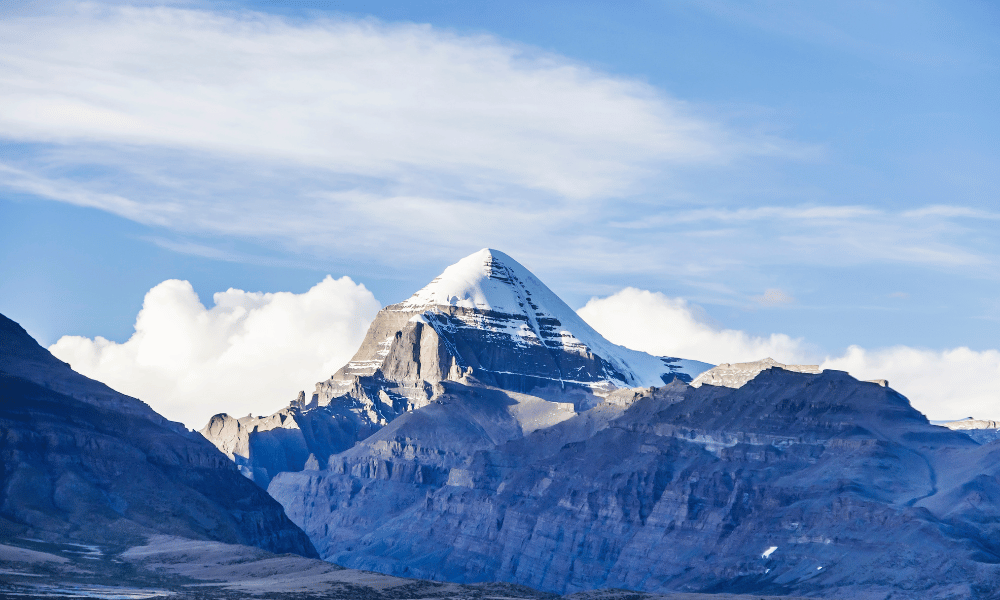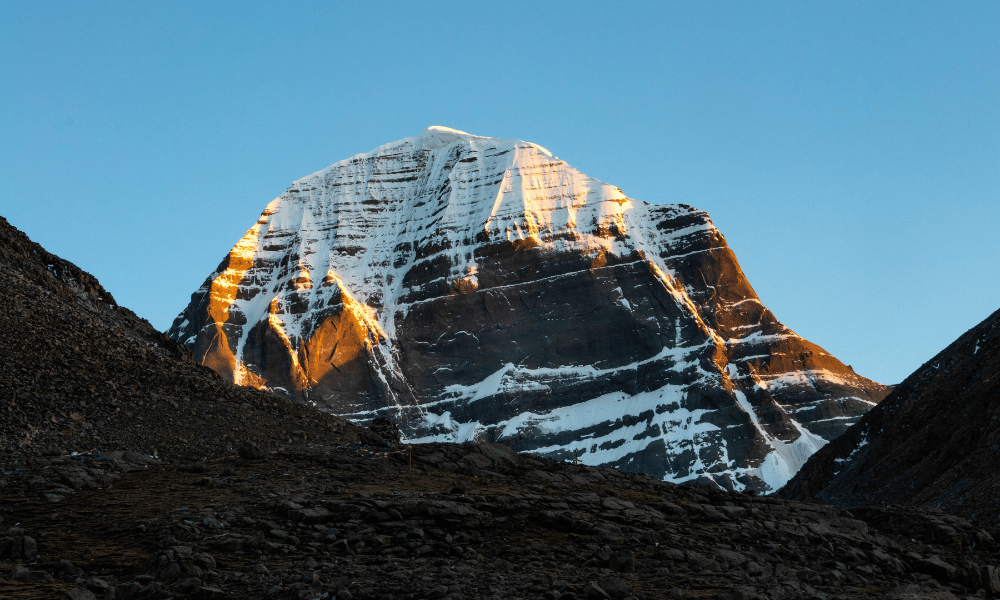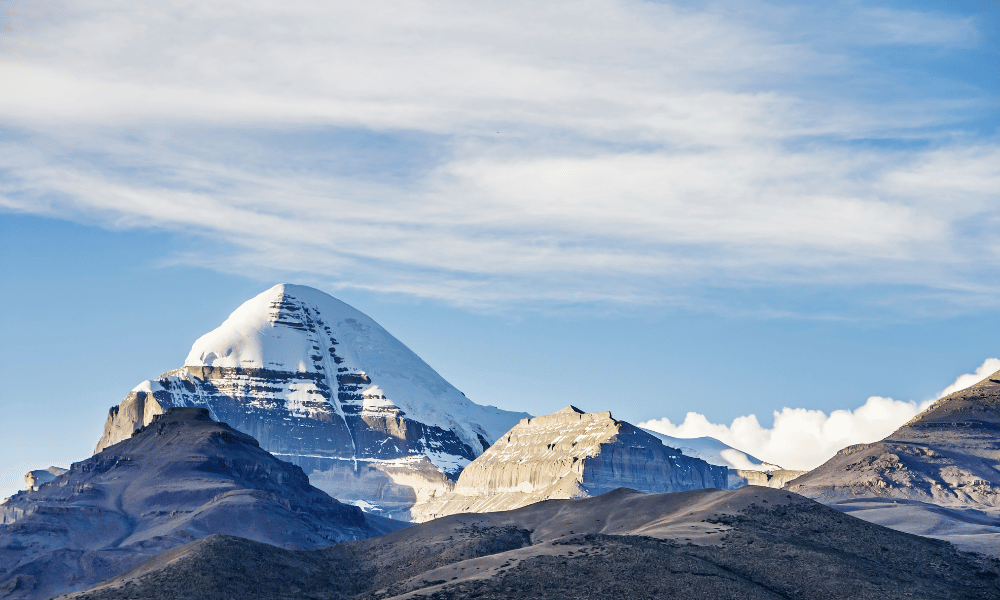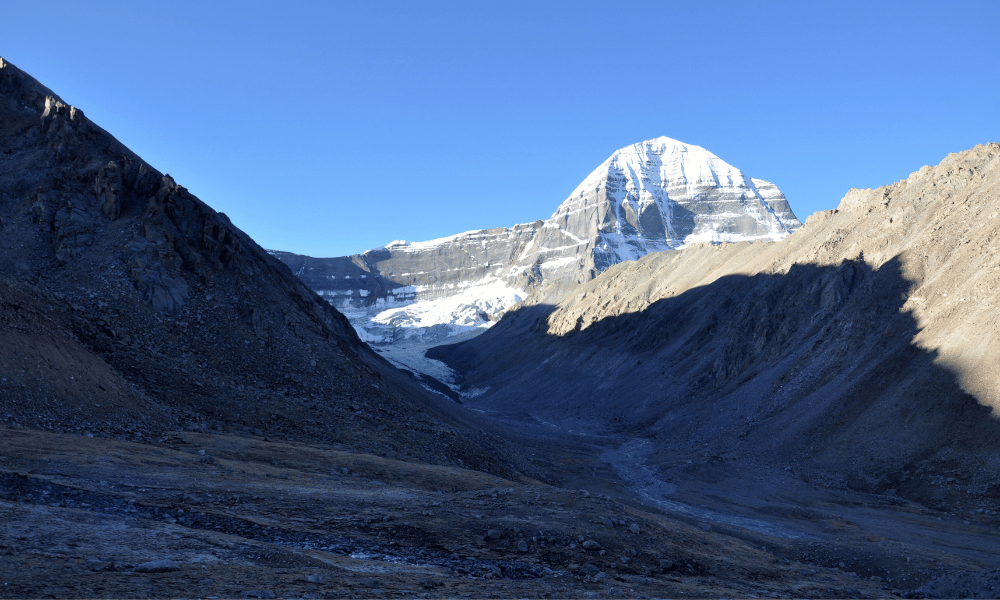The renowned Kailash Mansarovar Yatra is like stepping into a holy tapestry made of faith, old history, and stunning natural beauty. For lucky tourists leaving the USA, the trip starts with a beautiful stay in Nepal, which is a gateway to the beautiful scenery of Tibet. As travelers make their way through Kathmandu, the spiritual center of Nepal, they are about to have a life-changing experience that combines the rich cultural tapestries of Nepal with the deep spiritual meaning of Kailash Mansarovar. This blog is a complete guide for people who want to start this spiritual odyssey from the United States through Nepal. It explains all the details of a pilgrimage that offers not only a physical journey but also a journey into the deeper parts of oneself and faith.
Historical Significance
Nestled amidst the tranquil landscapes of the Tibet Autonomous Region, the Kailash Mansarovar Yatra is not just a pilgrimage but a journey retracing the footsteps of many enlightened beings and ancient travelers. The mysteries that surround Mount Kailash, believed to be the axis of the Earth, have captivated humanity for centuries. Over the millennia, this remote and enigmatic site has drawn pilgrims and adventurers alike, offering them a glimpse into its rich and storied past.
Religious Importance in Hinduism, Buddhism, Jainism, and Bon Religion
The Kailash Mansarovar region is a spiritual epicenter revered in several religions. In Hinduism, it is believed to be the abode of Lord Shiva and a place to attain Moksha. Buddhism considers it as the home of Demchok, a significant tantric deity, where pilgrims circumambulate the mountain to attain enlightenment. For Jains, it marks the spot where the first Jain Tirthankara, Rishabhdeva, attained liberation. Followers of the Bon religion, the ancient Tibetan spiritual belief, consider it a sacred site where their founder, Tonpa Shenrab Miwoche, descended from the sky. This confluence of spiritual beliefs and practices makes the Kailash Mansarovar a melting pot of diverse religious traditions, offering a unique spiritual experience to devotees worldwide.
Reasons to Choose Nepal as a Transit Point
Nepal is a great place to stop on your way to or from the Kailash Mansarovar Yatra. It has many advantages, both logistically and culturally. Nepal, which is between India and China, is a natural entrance to Tibet. It also makes it easy to get to Mount Kailash through well-worn paths. It also gives visitors a great chance to immerse themselves in Nepal's rich culture, which is known for its friendly people and many different customs. Many travelers who go on the Kailash Mansarovar Yatra choose to stay in Nepal so they can see the beautiful Himalayas up close and eat real Nepali food.
Geographical Advantage
Using Nepal as a transit point for the Kailash Mansarovar Yatra offers numerous benefits. Geographically, Nepal shares a direct border with the Tibet Autonomous Region, facilitating relatively easier access to the sacred site. Additionally, the capital city, Kathmandu, is well connected with various international airports, making it a convenient starting point for pilgrims coming from the USA and other parts of the world. The picturesque landscapes of Nepal also provide a serene backdrop, setting a peaceful precedent for the spiritual journey ahead.
Cultural Experience
Apart from its geographical proximity, Nepal offers a rich cultural experience that perfectly complements the spiritual journey to Kailash Mansarovar. The vibrant streets of Kathmandu are a living tapestry of history and spirituality, with centuries-old temples and bustling markets that offer an authentic and immersive Nepalese experience. Furthermore, the warm hospitality of the Nepalese people adds a comforting touch, making the transit through Nepal not just a journey, but a cultural feast enriching the soul even before reaching the holy mount.
Brief Overview of the Journey from the USA to Nepal
To start the Kailash Mansarovar Yatra from the United States, you have to travel a long way across countries. Most visitors from the United States first fly to Tribhuvan International Airport in Kathmandu, which is the capital of Nepal. This route not only makes it easy to move on to the next part of the Yatra, but it also gives you a chance to learn about Nepal's lively culture and historic sites. As you get ready to move on from Nepal to the holy mountains, your excitement builds. This is the start of an amazing spiritual journey that will change you and bring you closer to God.
GET AN INSTANT QUOTE, EMAIL US AT : KAILASH@HOLIDAYSTONEPAL.COM
Preparing for the Journey
The Kailash Mansarovar Yatra is both a spiritual and practical trip of great importance. Preparing well is the key to having a smooth and rewarding time. One of the most important things you can do to get ready is to know and meet the visa and permit standards. Here's what you need to know:
Visa and Permit Requirements
Before embarking on the spiritual journey of Kailash Mansarovar Yatra, it is essential to be equipped with the right documents to ensure a smooth and hassle-free travel experience. The first phase involves your travel from the USA to Nepal, followed by the pilgrimage from Nepal to Tibet, China. Here, we break down the necessary visa and permit requirements for each leg of the journey:
USA to Nepal
American citizens traveling to Nepal are generally eligible for a Visa-on-Arrival, making the process fairly straightforward. Here are the steps and requirements you need to note:
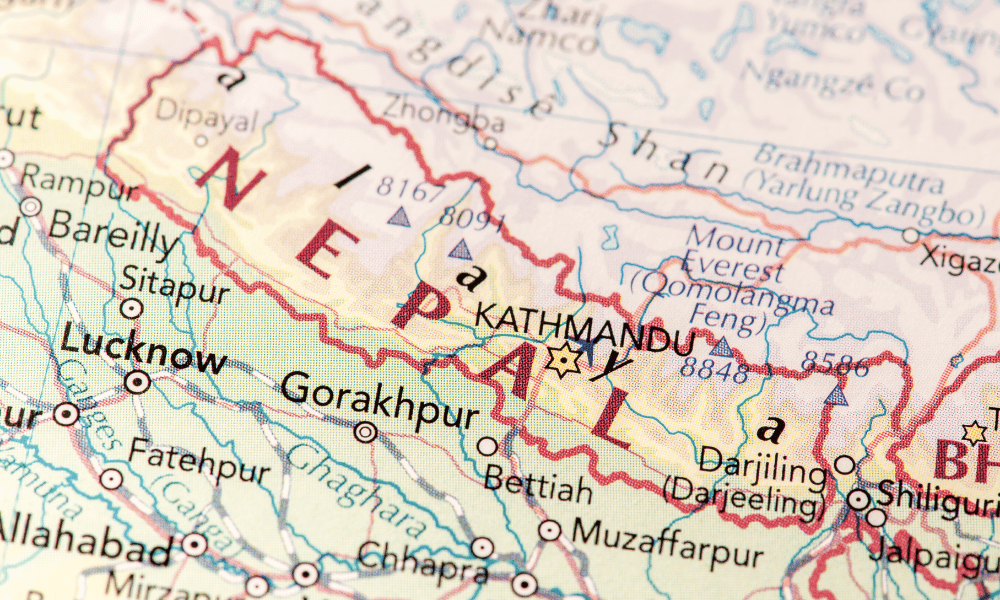
Visa-on-Arrival: Obtainable at Tribhuvan International Airport in Kathmandu. (Fill Nepal visa application online form here.)
Visa Duration: Options are available for a 15, 30, or 90-day tourist visa depending upon your travel plans. Hence for you a 15 days multiple entry visa would be suitable.
Documentation:
-
A valid passport with at least six months of validity beyond your planned stay.
-
A completed visa application form, which is available at the airport or online.
-
Passport-sized photos.
-
Proof of return flight or onward travel.
-
Payment for the visa fee, which varies based on the duration of the visa.
Nepal to Tibet (China)
Transitioning from Nepal to Tibet involves crossing international borders, and hence requires careful adherence to the visa and permit norms set by the Chinese government. Here are the necessary requirements:
Chinese Visa: Normally, if you were traveling directly to China, you would need a Chinese Visa. However, since you are entering Tibet via Nepal, you would need to get a special group visa from the Chinese Embassy in Kathmandu, even if you already possess a Chinese Visa.
Tibet Travel Permit: This is a compulsory document required for all foreign tourists entering Tibet. This permit is arranged by the tour operator you choose for the Yatra.
Documentation:
-
A valid passport. (6 months minimum)
-
Passport-sized photos.
Note: Given the changing nature of visa and permit requirements, it is always recommended to check the latest information and consult with your tour operator to ensure compliance with all necessary documentation and formalities.
Physical Fitness and Health Precautions
Venturing on the Kailash Mansarovar Yatra is not just a spiritual journey but also a physically demanding trek. To fully embrace and enjoy this once-in-a-lifetime experience, it is essential to be prepared both physically and health-wise. Here, we outline the necessary precautions and preparations you need to consider:
Altitude Sickness
The high altitudes of the Kailash Mansarovar region can pose a significant risk of altitude sickness, also known as Acute Mountain Sickness (AMS). Here’s how you can prepare and prevent AMS:
Acclimatization: Schedule your itinerary to include sufficient time for acclimatization to the high altitudes, which helps in reducing the risk of AMS.
Hydration: Stay hydrated by drinking plenty of fluids but avoid alcoholic beverages.
Medication: Consult with a healthcare provider to get prescription medication that can help prevent AMS.
Symptoms to Watch: Be aware of the symptoms of AMS, which include headaches, nausea, dizziness, and shortness of breath. Seek immediate medical assistance if you experience these symptoms.
Fitness Training
Preparing your body for the strenuous trek is vital. Here are some fitness training tips:
Cardiovascular Exercises: Engage in regular cardiovascular exercises like jogging, cycling, and swimming to build stamina.
Strength Training: Strengthen your leg muscles with exercises such as squats and lunges to prepare for the trek.
Flexibility: Incorporate yoga and stretching exercises to enhance flexibility and prevent injuries during the trek.
Altitude Training: If possible, try training at high altitudes to accustom your body to the conditions you will face during the Yatra.
Vaccinations
Before departing for the journey, ensure you are up-to-date with the necessary vaccinations to prevent illnesses. Here are the key points to consider:
Routine Vaccinations: Be up-to-date with routine vaccinations including measles-mumps-rubella (MMR), diphtheria-tetanus-pertussis, varicella (chickenpox), polio, and your yearly flu shot.
Travel Vaccinations: Consult with a healthcare provider to determine if you need additional vaccinations such as Hepatitis A & B, Typhoid, and Yellow Fever based on your travel itinerary.
COVID-19 Vaccination: Given the current global health scenario, ensure that you have received the necessary doses of the COVID-19 vaccine and carry proof of vaccination.
Travel Insurance: Consider purchasing comprehensive travel insurance that covers emergency healthcare services and evacuation if necessary.
By adhering to these physical fitness and health precautions, pilgrims can ensure a safer and more enjoyable journey to Kailash Mansarovar.
Packing Essentials
Embarking on the Kailash Mansarovar Yatra requires meticulous preparation when it comes to packing. To help you navigate through this vital aspect of the journey, here is a breakdown of the essentials that you should not forget:

Clothing
Given the diverse weather conditions you'll encounter, packing the right clothing is paramount. Here are the essential clothing items to pack:
Thermal Wear: Base layers of thermal wear to keep you warm in the freezing temperatures.
Insulating Layers: Fleece jackets or woolen sweaters to layer and retain body heat.
Outer Layer: Waterproof and windproof jackets to protect against rain and wind.
Trousers: Comfortable trekking trousers, preferably waterproof.
Headgear: Woolen caps or beanies to protect your head from the cold.
Footwear: Good quality, waterproof trekking boots with a strong grip and woolen socks.
Gloves: Waterproof and insulated gloves to protect your hands from the cold.
Sun Protection: Lightweight clothing to shield yourself from the sun at higher altitudes.
Medication
Being prepared with a well-stocked medical kit is essential. Here are the basics:
Altitude Sickness Medication: Prescription medication to prevent and treat altitude sickness.
Pain Relievers: Over-the-counter pain relievers for headaches or muscle pains.
Digestive Medicines: Medication to treat diarrhea and other digestive issues.
First-Aid Kit: Including band-aids, antiseptic creams, and gauze.
Personal Prescription Medication: If you have any personal medications, carry them in sufficient quantities.
Accessories
Apart from clothing and medication, here are some accessories that will come in handy:
Sunglasses: UV-protected sunglasses to protect your eyes from the harsh sun at high altitudes.
Sunscreen: A high SPF sunscreen to shield your skin from UV rays.
Water Bottle: A reusable water bottle to stay hydrated throughout the trek.
Backpack: A sturdy backpack with multiple compartments to carry your essentials.
Walking Stick: A reliable walking stick for support during the trek.
Flashlight: A flashlight or headlamp with extra batteries for the journey.
Camera: A camera to capture the breathtaking vistas and memorable moments.
Chargers and Power Bank: To keep your electronic devices charged during the journey.
Personal Hygiene Products: Including wet wipes, hand sanitizers, and a personal toiletry kit.
Remember, packing efficiently with all necessary items will ensure a comfortable and enjoyable experience during your Kailash Mansarovar Yatra.
Holidays to Nepal as Your Yatra Operator
Undertaking the Kailash Mansarovar Yatra is a spiritually enriching but logistically complex endeavor. Choosing the right Yatra operator can significantly influence the experience of your pilgrimage. Below, we detail some crucial factors to consider while selecting Holidays to Nepal as an operator for exemplary services.
Factors to Consider
Before you decide us as your Kailash Mansarovar Yatra operator, we ensure you following aspects for a smooth and safe pilgrimage trip:
Experience and Expertise:
Reputation: Holidays to Nepal is an experienced tour operator with a strong reputation and positive reviews from past pilgrims.
Knowledgeable Guides: We ensure to provide experienced guides who are well-versed with the region and its customs.
Safety and Medical Facilities:
Medical Assistance: Holidays to Nepal have provisions for basic and well equipped medical assistance during the Yatra.
Emergency Evacuation Plans: We are always prepared for emergencies and evacuation plans in case of any contingencies.
Accommodation and Logistics:
Comfortable Accommodations: We do provide the best available accommodations during the Yatra.
Transportation: We arrange comfortable transportation throughout the journey.
Customizable Packages:
Flexibility: Our customizable packages that will cater your different preferences and needs.
Budget Options: We do have multiple budget-friendly options without compromising on the safety and comfort of pilgrims.
Permits and Documentation:
Visa Assistance: We assist you with obtaining the necessary visas and permits.
Transparent Processes: We aim to be transparent during the trip operations and documentation processes.
Kailash Mansarovar Yatra - The Journey
The Kailash Mansarovar Yatra is a spiritual journey, but it is also a trip full of rich cultural experiences and beautiful sights. This part breaks down the schedule in depth, so you can carefully plan each step of the trip.
Flight to Nepal
Best Air Routes
Traveling from the USA to Nepal involves a long-haul flight, usually with one or more layovers. Here are some of the best and popular air routes that you might consider for a comfortable journey:
Via the Middle East:
-
USA to Doha (Qatar Airways) - Doha to Kathmandu
-
USA to Dubai (Emirates) - Dubai to Kathmandu
Via East Asia:
-
USA to Seoul (Korean Air) - Seoul to Kathmandu
-
USA to Hong Kong (Cathay Pacific) - Hong Kong to Kathmandu
Via Europe:
-
USA to Istanbul (Turkish Airlines) - Istanbul to Kathmandu
Note that the flight routes and availability might vary, and it is best to check with the airlines or a travel agent for the most current information.
Time Duration
The flight time from the USA to Nepal typically ranges from 18 to 25 hours or more, depending on the specific route chosen and the duration of the layovers. Consider the following:
East Coast to Kathmandu: Approximately 18 to 22 hours.
West Coast to Kathmandu: Approximately 20 to 25 hours.
These are estimated durations, and actual flight times may vary.
Jet Lag Tips
Given the long flight duration and the significant time difference between the USA and Nepal, jet lag is a common experience. Here are some tips to mitigate the effects of jet lag:
Adjust Your Schedule Before You Travel: A few days before your departure, try to gradually shift your sleeping and eating schedule to match the time zone of Nepal.
Stay Hydrated: Drink plenty of water before, during, and after your flight to help prevent jet lag.
Move Around During the Flight: To avoid stiffness and fatigue, make sure to walk around and stretch periodically during the flight.
Get Sunlight: Once you arrive, try to get some sunlight to help reset your internal body clock to the new time zone.
Avoid Alcohol and Caffeine: Avoid consuming alcohol and caffeine as they can disrupt your sleep cycle.
Take Short Naps: If necessary, take short naps to recover, but avoid long daytime sleeps as they can prolong jet lag.
By considering the best air routes, being mindful of the flight duration, and adopting measures to cope with jet lag, you can ensure a more comfortable and pleasant journey to Nepal as you embark on your Kailash Mansarovar Yatra.
Stay in Nepal
A gateway to the revered Kailash Mansarovar Yatra, Nepal is not just a transit point but a destination brimming with natural beauty and cultural richness. Ensuring a memorable stay in this diverse country is an integral part of your pilgrimage. Below we highlight the places you shouldn't miss and the cultural experiences that await you.
Places to Visit
During your stay in Nepal, take some time to explore the remarkable places that highlight the natural beauty and cultural heritage of the country. Here are some recommended places to visit:
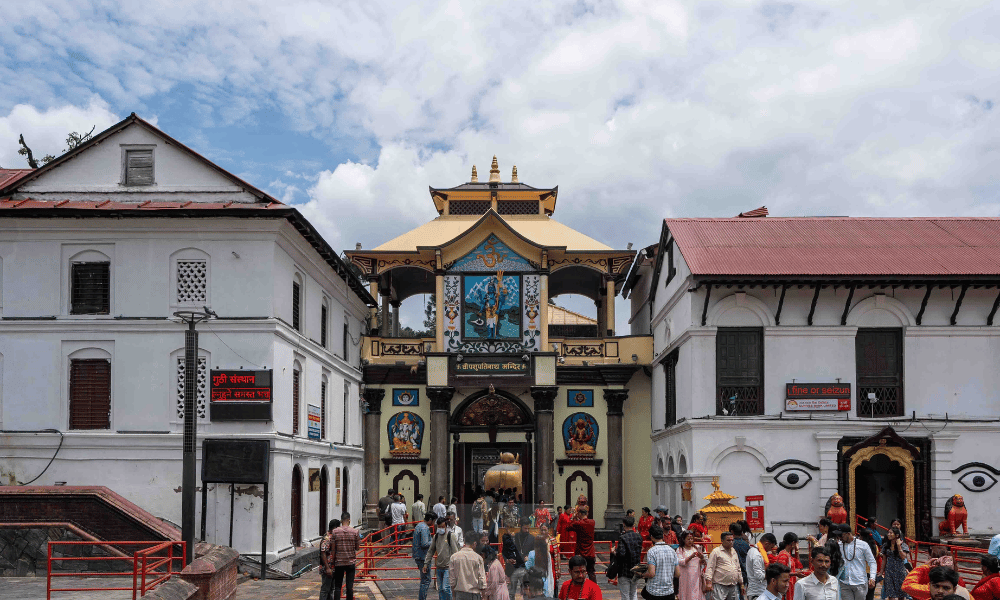
Kathmandu:
-
Swayambhunath Stupa (Monkey Temple): A historic and culturally significant site offering panoramic views of the city.
-
Pashupatinath Temple: A revered Hindu temple complex located on the banks of the Bagmati River.
-
Boudhanath Stupa: One of the largest stupas in the world, a center for Tibetan Buddhism.
-
Phewa Lake: Enjoy a boat ride on this picturesque lake with views of the Annapurna mountain range.
-
Davis Fall: A unique waterfall with a subterranean plunge, a popular tourist attraction.
Muktinath: Muktinath temple is a famous Hindu pilgrimage site which is believed to be the place of salvation.
Cultural Experience
Nepal offers a rich tapestry of cultural experiences, from its vibrant traditions to the warm hospitality of its people. Here are some ways to immerse yourself in the local culture:
Traditional Cuisine:
-
Dal Bhat: A staple meal consisting of lentil soup, rice, and vegetables.
-
Momo: A popular snack, these are steamed dumplings filled with meat or vegetables.
Cultural Performances:
-
Traditional Dance: Witness performances of traditional Nepali dances, which often tell stories from Hindu mythology.
-
Music: Enjoy the soothing melodies of traditional Nepali music, which incorporates instruments like the sarangi and Madal.
Craftsmanship:
-
Thangka Paintings: Admire the intricate Thangka paintings, a unique art form that often depicts Buddhist deities.
-
Handicrafts: Browse through local markets for beautiful handicrafts, including pottery, wood carvings, and woven textiles.
Festivals:
-
Dashain: The longest and the most significant Hindu festival celebrated in Nepal.
-
Tihar: Also known as Deepawali, it is marked by vibrant decorations and various traditional customs.
By exploring these places and immersing yourself in the cultural experiences, your stay in Nepal will surely be enriched, adding depth and context to your Kailash Mansarovar Yatra.
Journey from Nepal to Tibet
After soaking in the vibrant culture and breathtaking scenery of Nepal, the next leg of your pilgrimage is the journey to Tibet. This segment provides an overview of the available modes of transportation and the mesmerizing scenic views you can expect during this part of your Kailash Mansarovar Yatra.
Modes of Transportation
The journey from Nepal to Tibet can be undertaken through various modes of transportation, each offering a unique experience. Here are the popular options:
By Air:
Kathmandu to Lhasa: There are regular flights from Kathmandu to Lhasa, offering a quick and convenient mode of transport. This is an approximately 1.5-hour journey, presenting stunning aerial views of the Himalayan range.
Overland:
Kathmandu to Kyirong: This road journey, generally facilitated by tour operators, traverses through picturesque landscapes and allows for acclimatization to the high-altitude conditions. The journey usually takes about 7 to 8 hours.
Helicopter:
Kathmandu to Hilsa: Some tour operators offer helicopter services from Kathmandu to Hilsa, a border town in Nepal. From here, you will cross the border into Tibet by foot, followed by a drive to Mansarovar Lake.
Scenic Views
Whether by air or overland, the journey from Nepal to Tibet offers an array of breathtaking scenic views. Here are some highlights:
Himalayan Panorama: The Himalayan range offers an awe-inspiring backdrop throughout the journey, with glimpses of towering peaks including Mt. Everest.
Lush Valleys and Rivers: Witness the lush green valleys, terraced fields, and flowing rivers that adorn the landscapes between Nepal and Tibet.
Tibetan Plateau: As you approach Tibet, the terrain transforms into the high-altitude Tibetan plateau, characterized by its rugged mountainous beauty and pristine lakes.
Traditional Villages: Along the way, you may encounter traditional villages where you can witness the harmonious blend of Nepalese and Tibetan cultures.
Sacred Sites: Depending upon your route, you might pass by various sacred sites and monasteries, adding a spiritual dimension to your journey.
By choosing the appropriate mode of transportation and soaking in the scenic views, your journey from Nepal to Tibet can become an unforgettable part of your Kailash Mansarovar Yatra.
Arrival in Tibet and Acclimatization
As you step into the mystical lands of Tibet, you're not just crossing a geographical border, but entering a realm steeped in rich history and spiritual significance. A vital part of this transition is acclimatizing to the high-altitude conditions of the Tibetan Plateau. Below, we discuss the various places you can stay during this period and tips for successful acclimatization.
Places to Stay
Upon your arrival in Tibet, you can choose to stay at various comfortable and serene places that facilitate a smooth acclimatization process. Here are a few options:
Lhasa
Lhasa, the historic capital of Tibet, mesmerizes visitors with its rich cultural tapestry and iconic landmarks such as the Potala Palace and Jokhang Temple, offering a deep dive into Tibetan Buddhism's heartland. Nestled amidst breathtaking mountains, this vibrant city seamlessly blends tradition and modernity, offering a unique and enriching experience to every visitor.
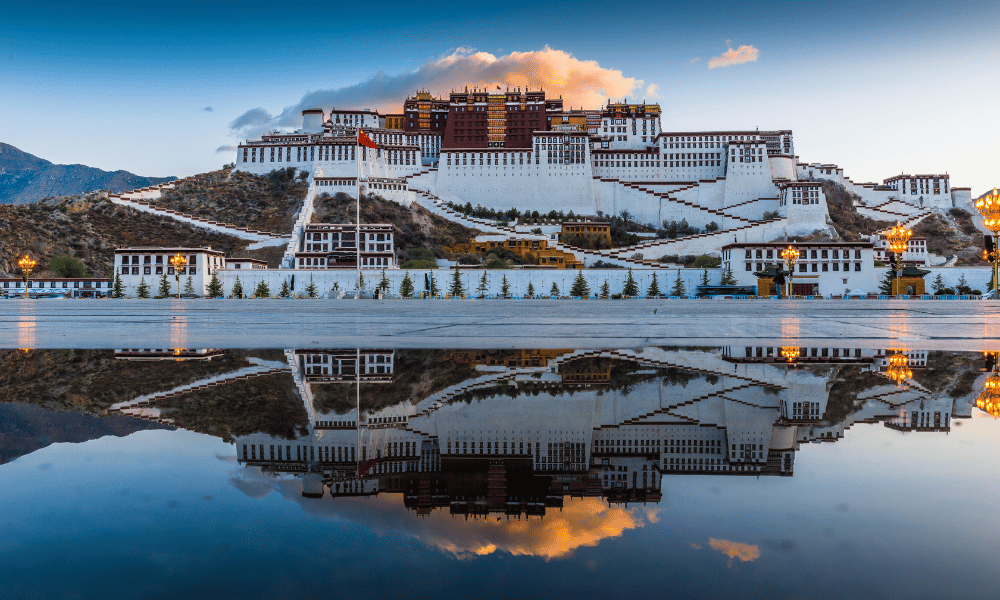
Budget Hotels: You'll find various budget-friendly hotels offering essential amenities.
Boutique Hotels: For a more luxurious stay, consider one of Lhasa’s boutique hotels that offer a blend of modern comforts and traditional Tibetan aesthetics.
Shigatse:
Shigatse, Tibet's second-largest city, welcomes travelers with its awe-inspiring scenery and grandiose monasteries, notably the historic Tashilhunpo Monastery, the seat of the Panchen Lama. As a nexus of culture and spirituality, it unfolds a rich narrative of Tibet’s royal and religious history, offering pilgrims a glimpse into the region's deep-seated traditions and vibrant spiritual life.
Guesthouses: Experience the local hospitality by staying at a cozy guesthouse.
Hotels: Shigatse also offers a range of hotels, from budget to premium, to cater to various preferences.
Kyirong
Kyirong, a picturesque Tibetan town, serves as an excellent base for the initial phase of your acclimatization. This area is known for its serene beauty and a tranquil environment that helps in a peaceful transition to the high altitudes.
Hotels and Guesthouses: There are several hotels and guesthouses available which offer basic amenities to ensure a comfortable stay.
Saga
Saga, a tranquil town en route to Mount Kailash, serves as a vital stopover, offering pilgrims a moment of respite amidst verdant landscapes and pristine rivers. Often referred to as the "Entrance to the Himalayas", this gateway town presents a harmonious blend of natural beauty and spiritual tranquillity, setting the tone for the spiritual voyage ahead.
Lodges and Guesthouses: In Saga, you will find a variety of lodges and guesthouses that offer basic amenities for a comfortable stay.
Lake Mansarovar
As you approach the sacred Lake Mansarovar, the accommodation options are more limited, but still offer a unique experience in this spiritual heartland.
Guest Houses: There are a few guest houses around the lake, offering basic facilities and a chance to stay close to the sacred waters.
Darchen
Darchen serves as the starting point for the Kailash circumambulation and offers a range of accommodation options to suit different preferences.
Hotels: You can find various hotels offering different levels of comfort and amenities, from basic to more upscale options.
Guesthouses: There are also several guesthouses that provide basic facilities for pilgrims.
Pre-Trek Preparations: Utilize your stay in Darchen to make last-minute preparations for the trek, including arranging porters and yaks if necessary.
Getting Acclimatized
Acclimatizing to the higher altitude of Tibet is a gradual process. Here are some tips to help you acclimate successfully:
Gradual Ascent: Try to ascend gradually, giving your body the time to adapt to the decreasing levels of oxygen.
Hydration: Staying hydrated is vital. Drink plenty of water to help your body cope with the dry mountain air.
Diet: Maintain a balanced diet rich in carbohydrates to provide you with the necessary energy during your acclimatization period.
Rest: Ensure you get sufficient rest to allow your body to recover and adapt to the new environment.
Medication: Consult with your healthcare provider about any medications that might help in preventing altitude sickness.
Physical Activity: Initially, avoid strenuous physical activities. Engage in light walks and exercises to help your body adapt gradually.
Symptoms to Watch: Be aware of the symptoms of altitude sickness, and consult a healthcare provider if you experience persistent symptoms.
By choosing comfortable accommodations and following guidelines for acclimatization, you can ensure a smooth and enjoyable transition into the breathtaking landscapes and spiritual ambiance of Tibet, a cornerstone of your Kailash Mansarovar Yatra.
The Kailash Yatra
Here is where the most important part of your trip starts. Immerse yourself in the holy mountains' spiritual hug and give in to the pure beauty all around you. The Yatra is both a physical trip and a mental journey to find out more about yourself.
The Trek
Embarking on the spiritual journey of Kailash Mansarovar Yatra involves trekking through some of the most beautiful yet challenging terrains. This section will guide you through the different stages of the trek and arm you with vital tips and tricks to make your trek successful.
Different Stages Kailash Parikarma
Embarking on the Kailash Mansarovar Yatra is not just a pilgrimage but a trek through diverse and challenging landscapes. Here, we break down the trek into different stages, each offering a unique experience:
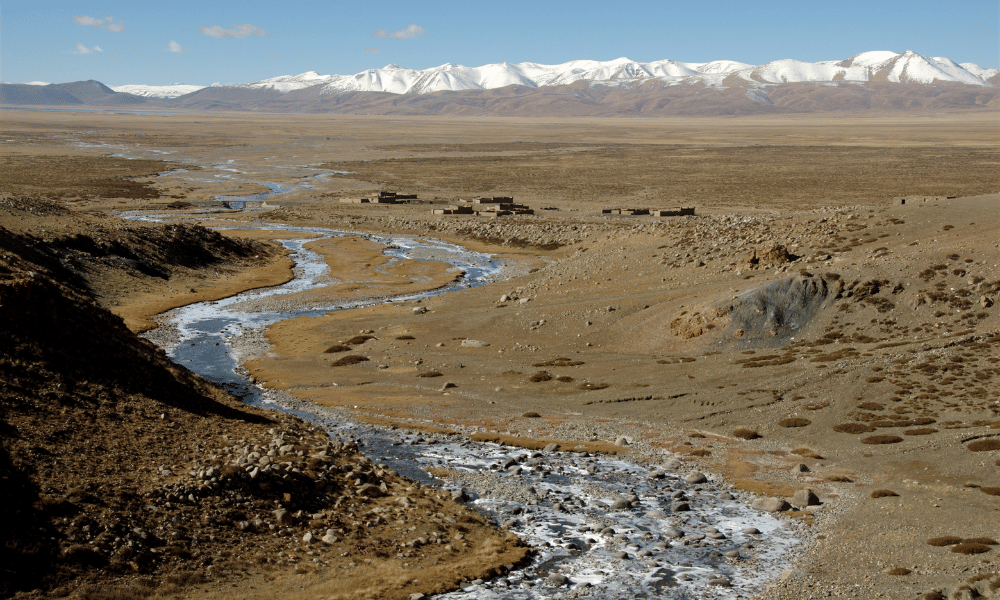
Darchen to Deraphuk:
-
Distance and Terrain: This is the first stage of the Kora, covering approximately 12 kilometers. The trail begins gently but gradually ascends, offering pilgrims breathtaking views of the north face of Mt. Kailash.
-
Landmarks and Scenic Beauty: The highlight of this stage is the Tarboche flagpole, an important religious site where the Tibetan festival of Saga Dawa is held. Pilgrims can also witness the stunning vistas of lush valleys and the roaring Lha-Chu River.
Deraphuk to Zuthulphuk:
-
Distance and Terrain: This is considered the most challenging part of the trek, spanning around 22 kilometers. Pilgrims traverse the Dolma La pass, which is situated at a high altitude of 5,640 meters.
-
Highlights: Apart from the Dolma La pass, other highlights include Gauri Kund, a sacred lake associated with Hindu mythology. The descent from the pass is steep and adorned with prayer flags, offering a spiritual ambiance.
Zuthulphuk to Darchen:
-
Distance and Terrain: This is the final leg of the trek, covering about 8 kilometers. The trail descends gradually, making it less strenuous compared to the previous stage.
-
Conclusion of the Trek: Pilgrims conclude their trek at Darchen, often filled with a sense of accomplishment and spiritual fulfillment. The Yatra is considered complete with the circumambulation of Mt. Kailash.
Tips and Tricks for a Successful Trek
To ensure a successful and fulfilling trek, here are some tips and tricks that might come in handy:
-
Physical Fitness: Begin preparing your body several months in advance, incorporating cardio exercises in your routine to build stamina and endurance.
-
Appropriate Gear: Invest in good quality trekking gear, including a comfortable pair of trekking boots, a sturdy backpack, and suitable clothing for varying weather conditions.
-
Hydration and Nutrition: Ensure to stay hydrated and carry energy-boosting snacks to refuel your body during the trek.
-
Guidance and Support: Considering the challenging terrain, it's advisable to undertake the trek under the guidance of experienced tour operators who offer support and assistance throughout the journey.
-
Altitude Sickness: Carry necessary medications and give your body time to acclimatize to prevent altitude sickness.
With proper preparation and adherence to these tips, pilgrims can look forward to a spiritually enriching and successful trek during their Kailash Mansarovar Yatra.
Spiritual Activities
The Kailash Mansarovar Yatra is much more than a physical journey; it's a voyage of spiritual discovery and inner transformation. From ancient rituals to profound personal experiences, this section provides insight into the rich spiritual activities that pilgrims can immerse themselves in during the Yatra.
Rituals
Partaking in age-old rituals is a significant aspect of the pilgrimage, bringing devotees closer to the divine energies believed to reside in the region. Here, we delve into some of the central rituals that form an intrinsic part of the Yatra:
Puja at Mansarovar Lake: Conducting or witnessing a Puja at the serene Mansarovar Lake is believed to cleanse the soul. Pilgrims seek blessings for a successful Yatra and partake in the holy ritual which involves offerings and prayers to Lord Shiva.
Holy Dip: Taking a holy dip in the Mansarovar Lake is considered to purify one’s body and soul. This sacred lake is believed to be a repository of blessings from Lord Shiva. The authorities don’t allow you to dip into the lake but you can take water in a bucket and bath at authorized points.
Parikrama/Kora: Undertaking the Kora or circumambulation of Mount Kailash is a vital ritual, believed to bring liberation and blessings. Pilgrims walk around the sacred mountain, a practice that is considered highly meritorious.
Inner Transformation
The Yatra often leads to deep personal transformations, as pilgrims find themselves in the midst of awe-inspiring landscapes and spiritual energies. Here, we explore the aspects of inner transformation that one might experience:
Meditation and Reflection: The tranquil surroundings provide an excellent backdrop for meditation and personal reflection. Pilgrims often find peace and clarity as they meditate in the holy land.
Spiritual Enlightenment: The journey offers a pathway to spiritual enlightenment, allowing individuals to connect with higher realms of consciousness and attain a deeper understanding of life and existence.
Bond with Fellow Pilgrims: As you traverse the challenging paths, a bond forms with fellow pilgrims. This sense of community and shared experiences often leads to lasting friendships and a deeper understanding of unity and compassion.
Personal Growth: Through the physical challenges and spiritual engagements, many find a deeper understanding of their strengths, resilience, and a renewed sense of purpose and direction in life.
By immersing themselves in the spiritual activities and embracing the potential for inner transformation, pilgrims find the Kailash Mansarovar Yatra to be a life-altering experience, bringing them closer to spiritual awakening and personal growth.
Interacting with Locals
Engaging with the locals along the route of the Kailash Mansarovar Yatra can be a rewarding experience, adding depth and richness to your pilgrimage. This section guides you on how to communicate and immerse yourself in the vibrant local cultures you'll encounter during your journey.
Language
Communicating with the locals can be a delightful experience, enhancing your understanding of the region’s culture and traditions.
Cultural Exchange
Engaging in cultural exchange can be a deeply enriching aspect of the journey. Here’s how pilgrims can embrace the vibrant local cultures:
Local Customs and Traditions: Introduce readers to the local customs, traditions, and etiquettes of the region, helping them navigate interactions with sensitivity and respect.
Community Involvement: Discuss opportunities for visitors to get involved with local communities, be it through community meals, participation in local festivals, or attending cultural performances.
Souvenirs and Craftsmanship: Highlight the unique crafts of the region, encouraging readers to support local artisans by purchasing handmade souvenirs, which not only serve as a memento of their journey but also help in uplifting the local economy.
Culinary Experiences: Guide readers on how to immerse themselves in the local culinary scene, mentioning must-try dishes and traditional delicacies of the region.
Stories and Folklore: Mention how interacting with locals can be a rich source of stories and folklore, adding a fascinating dimension to the pilgrimage.
By fostering respectful and enriching interactions with the locals, pilgrims can gain a deeper appreciation of the region's rich cultural tapestry, making their Kailash Mansarovar Yatra a truly holistic experience.
Highlights and Attractions
The Kailash Mansarovar Yatra is dotted with awe-inspiring sights and spiritually significant locations. In this section, we turn our attention towards Lake Mansarovar, a place of great religious and aesthetic significance that captivates every visitor with its pristine beauty and peaceful ambiance.
Lake Mansarovar
Standing at the foot of Mount Kailash, Lake Mansarovar is not only a visual treat but a place infused with spiritual energy. Here we delve deep into its significance and the activities one can indulge in while visiting this heavenly place.
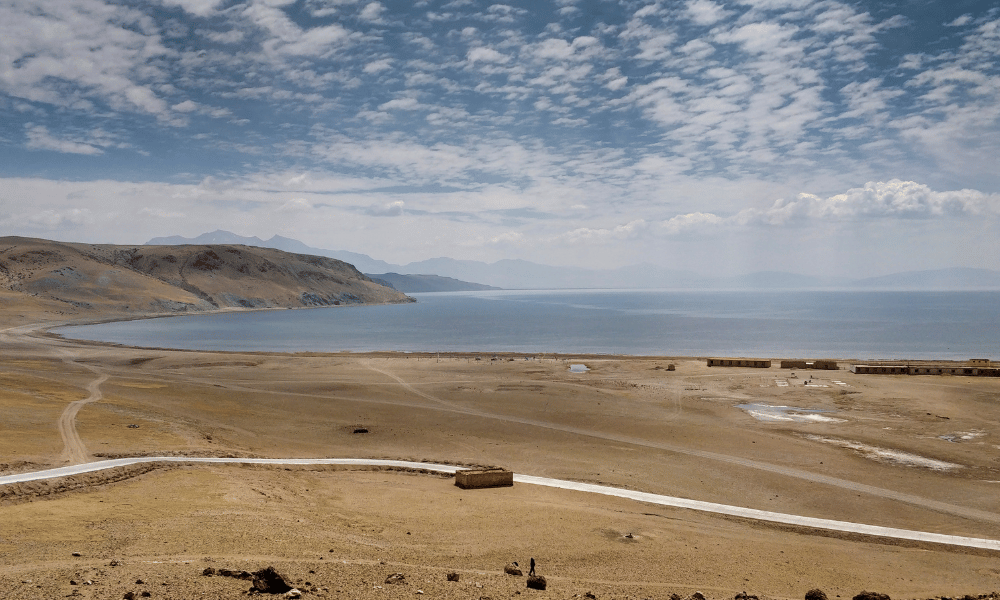
Significance
-
Religious Importance: Discuss how Lake Mansarovar holds a sacred place in Hinduism, Buddhism, and Jainism. Mention how it is believed to be the manifestation of purity, capable of cleansing one’s sins and bringing salvation.
-
Mythological Connections: Talk about the lake's connections to various mythological stories, including its mention in the ancient texts like the Ramayana and the Mahabharata.
-
Natural Beauty: Describe the surreal beauty of the lake, with its crystal-clear waters reflecting the towering Himalayan peaks. Mention the changing hues of the lake, which mesmerize visitors with their ethereal beauty.
Activities
-
Holy Dip: Describe the ritual of taking a holy dip in the lake, believed to purify the mind and body. Mention the best spots around the lake for this ritual.
-
Parikrama of the Lake: Explain the ritual of performing a Parikrama or circumambulation of the lake, a spiritual activity that many pilgrims undertake to pay homage and seek blessings.
-
Meditation and Yoga: Mention the tranquil surroundings of the lake as being ideal for meditation and yoga. Describe how pilgrims can immerse themselves in spiritual practices amidst the tranquil ambiance.
-
Photography: Highlight the photographic opportunities the lake offers, with its picturesque surroundings providing the perfect backdrop for capturing memorable moments.
-
Bird Watching: Talk about the rich avian life in the region, making it a haven for bird watchers. Suggest the best times for bird watching and the species one might encounter.
By exploring the significance and the array of activities that Lake Mansarovar offers, pilgrims can have a spiritually enriching and aesthetically pleasing experience, making their Yatra truly unforgettable.
Mount Kailash
Mount Kailash, standing tall at 6638 meters, is more than just a majestic peak in the Trans Himalayan range. It is considered the spiritual center of the universe by several religions and has mystified visitors with its unique, symmetrical appearance and the profound spiritual experiences it offers. This section explores the significance of Mount Kailash and what one can expect from the trekking experience in this sacred region.
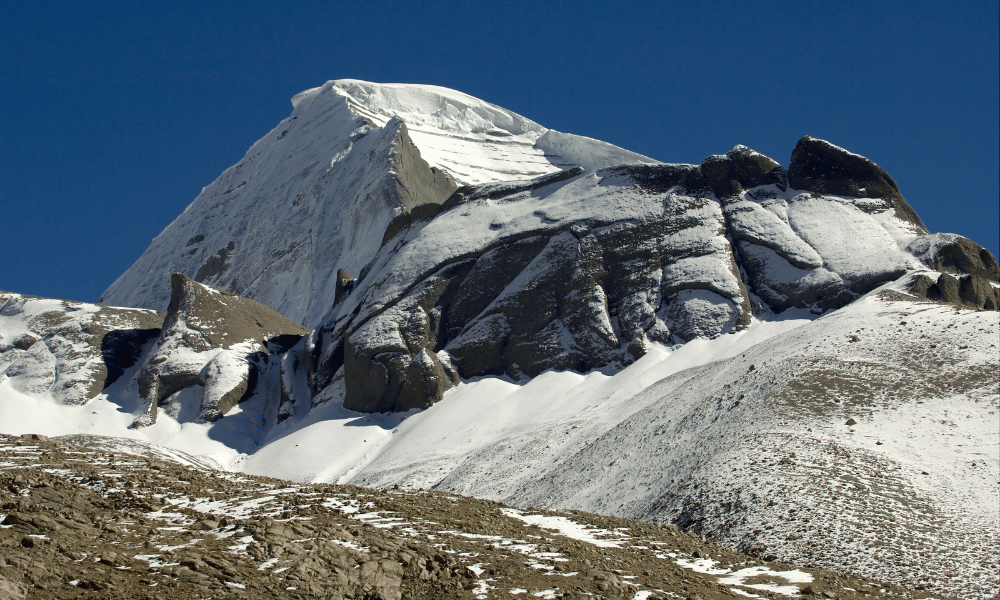
Significance
-
Spiritual Epicenter: Elaborate on how Mount Kailash is revered as a sacred place in various religions such as Hinduism, Buddhism, Jainism, and Bon. Discuss the mythologies and beliefs associated with it in these religions.
-
Geological Wonder: Discuss the geological aspects of Mount Kailash, explaining how its unique, symmetrical structure and its isolated location amidst the vast Tibetan plateau have fascinated geologists and visitors alike.
-
Source of Four Rivers: Mention that the mountain is the source of some of the subcontinent’s major rivers, including the Brahmaputra and the Indus, and discuss the ecological significance of the region.
Trekking Experience
-
Challenging Yet Rewarding: Describe the trekking experience as a challenging yet rewarding journey, with strenuous trails offering breathtaking views and deep spiritual connections.
-
The Outer Kora: Provide insights into the Outer Kora, a popular trekking route that takes pilgrims around the base of Mount Kailash, offering a chance to soak in the mountain’s majestic beauty and spiritual energy.
-
Serene Landscapes: Paint a picture of the serene landscapes that greet trekkers along the way, with vistas of sprawling meadows, pristine rivers, and towering peaks that are a feast for the eyes.
-
Spiritual Connection: Explain how the trek offers an unparalleled opportunity for spiritual connection, with various points along the route holding religious significance and offering spaces for meditation and reflection.
-
Guided Treks: Mention the availability of guided treks, which provide assistance and insights throughout the journey, ensuring a safe and enriching trekking experience.
By delving into the mystical significance and offering a glimpse of the trekking experience at Mount Kailash, this section aims to prepare pilgrims for a journey that promises not just physical adventure, but a deep spiritual exploration and personal transformation.
Other Attractions
The Kailash Mansarovar Yatra is not just about the serene Lake Mansarovar and the majestic Mount Kailash. The journey is sprinkled with several other attractions that captivate the pilgrims with their beauty and spiritual significance. In this section, we will uncover the ancient monasteries that narrate tales of time and the rejuvenating hot springs that are a testament to the region's geological richness.
Ancient Monasteries
The region surrounding Mount Kailash is dotted with ancient monasteries that resonate with spirituality and historical significance. Here, we delve into a few renowned ones:
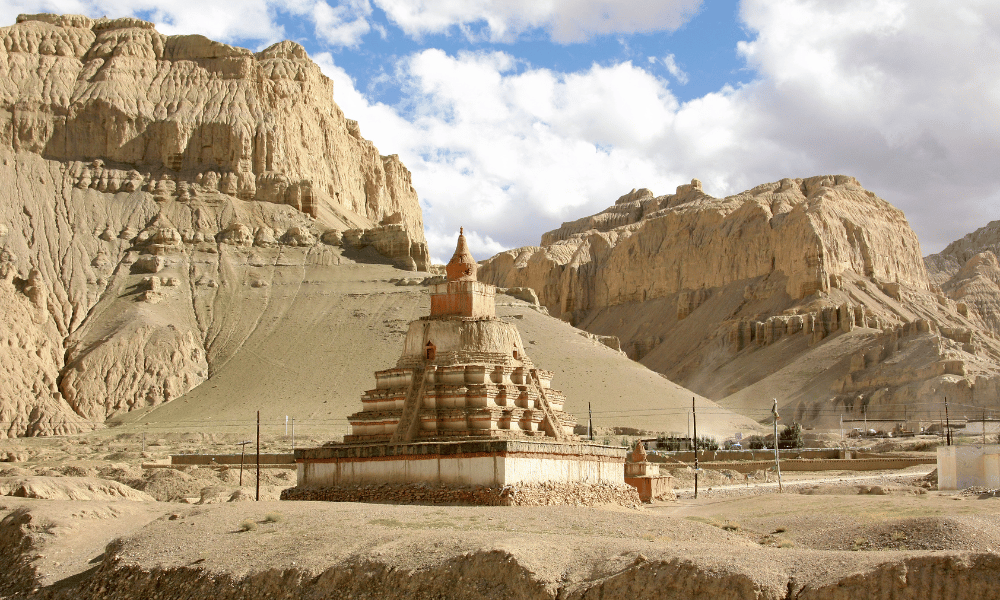
-
Tholing Monastery: Talk about this ancient monastery, which is one of the oldest in Tibet, known for its rich collection of scriptures, murals, and sculptures.
-
Zanda Monastery: Discuss this monastery, known for its stunning architecture and its significance in the Bon religion.
-
Chiu Monastery: Highlight this monastery that stands overlooking the Mansarovar Lake, offering splendid views and a serene environment for reflection and meditation.
-
Serlung Monastery: Mention this monastery, a significant destination for those seeking to explore the caves where Guru Rinpoche is believed to have meditated.
Hot Springs
Apart from the spiritual journey, the region offers a natural retreat with its hot springs known for their healing properties. Let’s explore a few popular ones:
Tirthapuri Hot Springs: Describe these hot springs that are often visited after the Kailash Mansarovar Yatra for their rejuvenating properties, allowing pilgrims to unwind and relax.
Gauri Kund: Talk about this sacred hot spring, also known as the Lake of Compassion, believed to have medicinal properties and a significant place in Hindu mythology.
Rakshas Taal: Mention this neighboring lake of Mansarovar, with its hot springs offering a tranquil setting to relax and soak in the beautiful surroundings.
By exploring these ancient monasteries and rejuvenating hot springs, pilgrims can immerse themselves in a journey that transcends time, connecting them to ancient traditions and offering moments of relaxation and reflection amidst the natural beauty of the region.
Return Journey from Kailash Yatra
As the end of your spiritually enriching trip draws near, you start to get ready to go back to your busy life at home. This section walks you through the steps and procedures you need to take to leave Tibet smoothly and keep the memories you made on the holy Yatra.
Leaving Tibet
As the spiritual and adventurous journey of the Kailash Mansarovar Yatra draws to a close, the return journey begins, bringing with it a time of reflection and contemplation. In this section, we will explore the practical aspects of leaving Tibet and how to meaningfully reflect on the profound experiences gained during the Yatra.
Exit Formalities: Discuss the necessary exit procedures, including documentation checks and customs regulations that pilgrims need to adhere to when leaving Tibet.
Traveling to Nepal: Mention the modes of transportation available for the journey back to Nepal, touching upon the travel time and the scenic routes that one might take during the return journey.
Safety Measures: Highlight the safety measures to be kept in mind, including health precautions and securing belongings, ensuring a safe and smooth return journey.
Visa and Permit: Remind pilgrims to keep their visas and permits handy, discussing the processing time and locations where these checks will be conducted.
Customs Declarations: Inform about the customs declaration process, highlighting items that are restricted or prohibited from being taken out of Tibet.
Health Checks: If applicable, discuss the potential health checks in place due to prevailing health conditions or global health advisories.
Reflecting on the Experience
Personal Reflections: Encourage pilgrims to take time to reflect on their personal experiences, assimilating the spiritual insights and personal transformations that the journey has bestowed upon them.
Journaling: Suggest the practice of journaling as a means to capture the profound experiences and learnings gained during the Yatra.
Sharing Stories: Motivate readers to share their stories and experiences with others, fostering a community of like-minded individuals who have shared this transformative journey.
Photographic Memories: Recommend creating a photo album or digital collage as a beautiful way to reminisce and share the mesmerizing moments captured during the Yatra.
Giving Back: Discuss how returning pilgrims can give back to the communities they visited, either through charitable contributions or by promoting responsible tourism in the region.
As pilgrims make their way back home, this return journey is an opportune time to ponder upon the spiritual enrichment and personal growth achieved during the Kailash Mansarovar Yatra, taking with them memories and experiences that will resonate with them for a lifetime.
Stay in Nepal
After the intense and spiritual journey through the Kailash Mansarovar Yatra, your stay in Nepal offers a transition back to daily life, but with a fresh perspective and a renewed spirit. This part of the journey allows you to soak in more of the vibrant Nepalese culture, explore its picturesque landscapes, and bring home souvenirs that carry the essence of this heavenly place.
Shopping for Souvenirs
Traditional Artifacts: Discuss the various traditional artifacts one can purchase as souvenirs, including Thangka paintings, Pashmina shawls, and handmade jewelry.
Local Markets: Provide information about popular local markets where visitors can find a variety of souvenirs, such as Thamel Market in Kathmandu.
Bargaining Tips: Offer tips on how to bargain effectively in local markets to get the best deals.
Sustainable Shopping: Encourage readers to shop sustainably by purchasing locally made products, supporting small businesses and artisans.
Exploring More of Nepal
Cultural Heritage Sites: Suggest visiting UNESCO World Heritage Sites like Kathmandu Durbar Square, Patan Durbar Square, and Bhaktapur Durbar Square for a deep dive into Nepal's rich cultural heritage.
Natural Attractions: Advocate for visits to natural attractions like Pokhara, known for its stunning lakes and panoramic views of the Himalayas.
Adventure Activities: Introduce readers to various adventure activities available in Nepal such as trekking, white water rafting, and paragliding for those seeking a bit more thrill.
Gastronomical Experience: Encourage readers to indulge in the gastronomical delights of Nepal, exploring the diverse culinary landscape with dishes like Momos, Dhido, and Newari cuisine.
Spiritual Retreats: Mention the opportunity to extend the spiritual journey with retreats or visits to sacred places like Lumbini, the birthplace of Buddha.
As your journey comes to a close, the stay in Nepal offers an amalgamation of cultural immersion, exploration, and a touch of adventure, ensuring that you return home with a bag full of memories and experiences that are both enriching and rejuvenating.
Flight Back to the USA
As the divine journey comes full circle, it's time to embark on the journey back to the USA. This section offers insights into the flight options available for a comfortable journey back home and tips on how to navigate the post-trip blues that might follow such a transformative experience.
Flight Options
-
Booking in Advance: Mention the importance of booking return flights well in advance to avoid last-minute price surges and availability issues.
-
Airlines and Routes: Discuss various airlines and routes that operate between Nepal and the USA, suggesting options that offer the most comfort and convenience.
-
Connecting Flights: Inform about the main connecting cities for flights back to the USA, focusing on the ones that might offer interesting layover experiences or shorter transit times.
-
Customs and Immigration: Provide information on what to expect during customs and immigration processes when re-entering the USA, including any duty-free allowances or necessary declarations.
Dealing with Post-Trip Blues
-
Reintegration into Daily Life: Offer tips on how to gently reintegrate into daily life, perhaps suggesting a gradual return to routine while keeping the newfound peace and insights intact.
-
Sharing Your Experience: Encourage readers to share their experiences with family and friends, perhaps even suggesting hosting a small gathering or a photo sharing session as a way to reminisce and share the journey with others.
-
Personal Reflection: Recommend setting aside time for personal reflection to assimilate the lessons and insights gained during the journey, which can often be transformative and deeply personal.
-
Planning Your Next Adventure: Suggest starting to think about the next adventure, as having something to look forward to can often alleviate the post-trip blues.
-
Creative Outlets: Encourage readers to channel their experiences into creative outlets like writing a blog post, painting, or creating a photo album that captures the spirit of their journey.
As you step back onto home ground, the Kailash Mansarovar Yatra leaves you with a treasure trove of memories, spiritual enrichment, and a rejuvenated sense of being. While post-trip blues are natural, channeling the energy and inspiration from the Yatra into positive avenues can be a fulfilling and enriching process, marking the beginning of a new chapter of inner exploration and growth.
Kailash Mansarovar Yatra by Drive
|
Day 01 |
Kathmandu Arrival. |
|
Day 02 |
Kathmandu Sightseeing. (Tibet visa application/takes 4 days) |
|
Day 03 |
Kathmandu Sightseeing. |
|
Day 04 |
Kathmandu Sightseeing. |
|
Day 05 |
Kathmandu Sightseeing and Packing. |
|
Day 06 |
Kathmandu to Timure/Rasuwa Gadhi. |
|
Day 07 |
Timure/Rasuwa Gadhi to Kyirong. (Tibet Entry) |
|
Day 08 |
Kyirong to Saga. |
|
Day 09 |
Saga to Lake Mansarovar. |
|
Day 10 |
Lake Mansarovar to Darchen. |
|
Day 11 |
Darchen to Dirapuk. (Yatra Day 1, 12 KM) |
|
Day 12 |
Dirapuk to Zuthulphuk. (Yatra Day 2, 22 KM) |
|
Day 13 |
Zuthulphuk to Saga. (Yatra Day 3, 8 KM) |
|
Day 14 |
Saga to Kyirong. |
|
Day 15 |
Kyirong to Kathmandu. |
|
Day 16 |
Departure. |
Kailash Mansarovar Yatra by Drive Dates
|
Month |
Starting Date |
|
May 2024 |
5, 12, 19, 26 |
|
June 2024 |
2, 9, 16, 23 |
|
July 2024 |
7, 14, 21, 28 |
|
August 2024 |
4, 11, 18, 25 |
|
September 2024 |
1, 8, 15 |
Kailash Mansarovar Yatra by Drive Cost
|
Group Size |
Deluxe Package (3 Star Hotel in Kathmandu) |
Luxury Package (5 Star Hotel in Kathmandu) |
|
4 People |
USD 3000 Per Person |
USD 3500 Per Person |
|
6 People |
USD 2900 Per Person |
USD 3400 Per Person |
|
10 People |
USD 2700 Per Person |
USD 3200 Per Person |
|
14 People |
USD 2600 Per Person |
USD 3100 Per Person |
|
20 People |
USD 2500 Per Person |
USD 3000 Per Person |
Kailash Mansarovar Yatra by Helicopter
|
Day 01 |
Kathmandu Arrival. |
|
Day 02 |
Kathmandu Sightseeing. (Tibet visa application/takes 4 days) |
|
Day 03 |
Kathmandu Sightseeing. |
|
Day 04 |
Kathmandu Sightseeing. |
|
Day 05 |
Fly to Nepalgunj. |
|
Day 06 |
Nepalgunj to Simikot. |
|
Day 07 |
Simikot - Hilsa - Taklakot. |
|
Day 08 |
Rest Day for acclimatization in Taklakot. |
|
Day 09 |
Taklakot to Lake Mansarovar. (4550m) |
|
Day 10 |
Drive to Yama Dwara, Trek to Deruphuk. (4909m) (12 KM) |
|
Day 11 |
Trek to Zuthulphuk. (4760m) (22 KM) |
|
Day 12 |
Zuthulphuk to Hilsa or Simikot. (8 KM) |
|
Day 13 |
Hilsa to Simikot, fly to Nepalgunj and fly back to Kathmandu. |
|
Day 14 |
Departure. |
Kailash Mansarovar Yatra by Helicopter Dates
|
Month |
Starting Date |
|
May 2024 |
5, 19, 26 |
|
June 2024 |
29, 16, 23 |
|
July 2024 |
7, 21, 28 |
|
August 2024 |
11, 18, 25 |
|
September 2024 |
8, 15 |
Kailash Mansarovar Yatra by Helicopter Cost
|
Group Size |
Deluxe Package (3 Star Hotel in Kathmandu) |
Luxury Package (5 Star Hotel in Kathmandu) |
|
4 People |
USD 4200 Per Person |
USD 4800 Per Person |
|
6 People |
USD 4100 Per Person |
USD 4700 Per Person |
|
10 People |
USD 3900 Per Person |
USD 4500 Per Person |
|
14 People |
USD 3800 Per Person |
USD 4400 Per Person |
|
20 People |
USD 3700 Per Person |
USD 4300 Per Person |
Read More : Kailash Mansarovar Yatra by Helicopter via Hilsa
Overall Conclusion
As we reach the end of this comprehensive guide to the Kailash Mansarovar Yatra via Nepal, it becomes clear that this pilgrimage is not just a physical journey, but a voyage of personal growth and spiritual awakening. The paths winding around sacred mountains and the tranquil waters of Mansarovar are a catalyst for inner transformation. As you prepare to embark on this sacred journey, let's take a moment to reflect on the deeper experiences that await and offer some tips for future travelers to make the most of this spiritual adventure.
Reflecting on the Experience
Reflecting on the experiences of the Yatra, it becomes apparent that it is more than just a pilgrimage. It's a journey where nature and spirituality converge, offering an opportunity to reconnect with oneself and the divine energies that permeate this sacred region. We encourage every traveler to take moments of stillness, to absorb the profound energy of the place, and to internalize the transformative experiences that the Yatra bestows.
Personal Growth
Personal growth is an inevitable part of this journey. As you navigate the challenging terrains, you not only test your physical endurance but also cultivate virtues of patience, resilience, and humility. You return not just with captivating stories but with a refined perspective on life, a deeper understanding of yourself, and a heart filled with gratitude and compassion.
Spiritual Awakening
The Kailash Mansarovar Yatra is not just a trek through picturesque landscapes but a pathway to spiritual awakening. The holy sites, rituals, and the profound energy of Mount Kailash serve to awaken a deeper sense of spirituality within, guiding you towards inner peace, harmony, and a renewed sense of connection with the divine.
Tips for Future Travellers
Preparation is Key: Equip yourself with all necessary information and ensure you are physically and mentally prepared for the journey.
Respect the Environment: Embrace the principles of responsible tourism by respecting the local environment and culture.
Personal Reflection: Incorporate time for personal reflection and meditation to fully absorb the spiritual essence of the journey.
Community Engagement: Engage with the local community in a respectful and meaningful way, learning from their wisdom and sharing your experiences.
Document Your Journey: Keep a journal or a blog to document your personal experiences, insights, and the beautiful moments that define your Yatra.
The Kailash Mansarovar Yatra is a transformative journey, offering a unique blend of adventure, spirituality, and personal growth. As you step onto the sacred grounds, may you find what you seek and may the journey bring you peace, joy, and a deeper connection with your inner self. We hope this guide serves as a helpful companion as you embark on this journey of a lifetime.
Frequently Asked Questions
What is the best time to undertake the Kailash Mansarovar Yatra?
Answer: The best time to undertake the Yatra is between May and September when the weather is relatively stable and the temperatures are moderate, allowing for a safer and more comfortable journey.
How long is the entire Kailash Mansarovar Yatra, including the transit through Nepal?
Answer: The entire Yatra, including the transit through Nepal, generally takes about 15 to 20 days. However, the duration may vary depending upon the itinerary chosen and the pace of travel.
Do I need any special permits for the Yatra?
Answer: Yes, you will require several permits including the Tibet Travel Permit, Alien's Travel Permit, and the Military Permit. These are generally arranged by the tour operator you choose.
What kind of fitness level is required for the Yatra?
Answer: Given the challenging terrains and high altitudes, it's recommended that pilgrims have a good level of physical fitness. Undertaking regular fitness training a few months before the Yatra can be beneficial.
Can I undertake the Yatra independently without a tour operator?
Answer: It is highly recommended to undertake the Yatra through a registered tour operator, as they can assist with necessary permits, logistics, and ensure safety and comfort during the journey.
What kind of accommodation options are available during the Yatra?
Answer: Accommodation options vary along the route, ranging from hotels and guest houses in Nepal to more basic guesthouses and tented camps during the trekking parts of the Yatra.
Is it safe to drink the water from Lake Mansarovar?
Answer: While the water in Lake Mansarovar is considered sacred, it is advisable to drink bottled or purified water to avoid any health issues.
What are the communication facilities available during the Yatra?
Answer: Communication facilities may be limited during the trekking parts of the Yatra. However, in larger towns and cities, you'll find internet and mobile phone coverage.
Can I charge my electronic devices during the Yatra?
Answer: Yes, you can charge your devices at the hotels and guesthouses. However, electricity might be sporadic in remote areas, so it's a good idea to carry power banks.
What kind of medical facilities are available during the Yatra?
Answer: While basic medical facilities are available at various points during the Yatra, it is recommended to carry a personal medical kit with necessary medications and first aid supplies.


